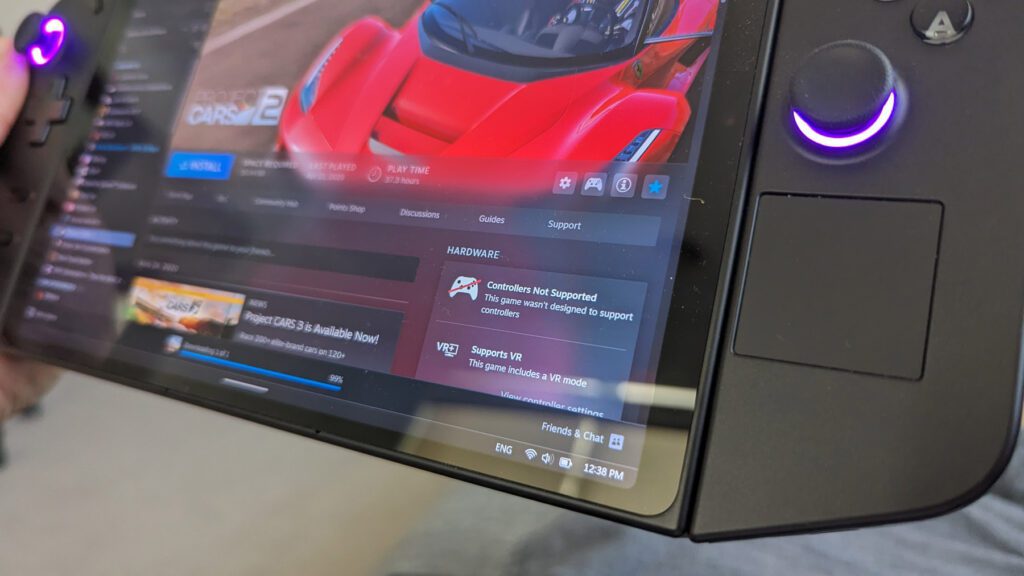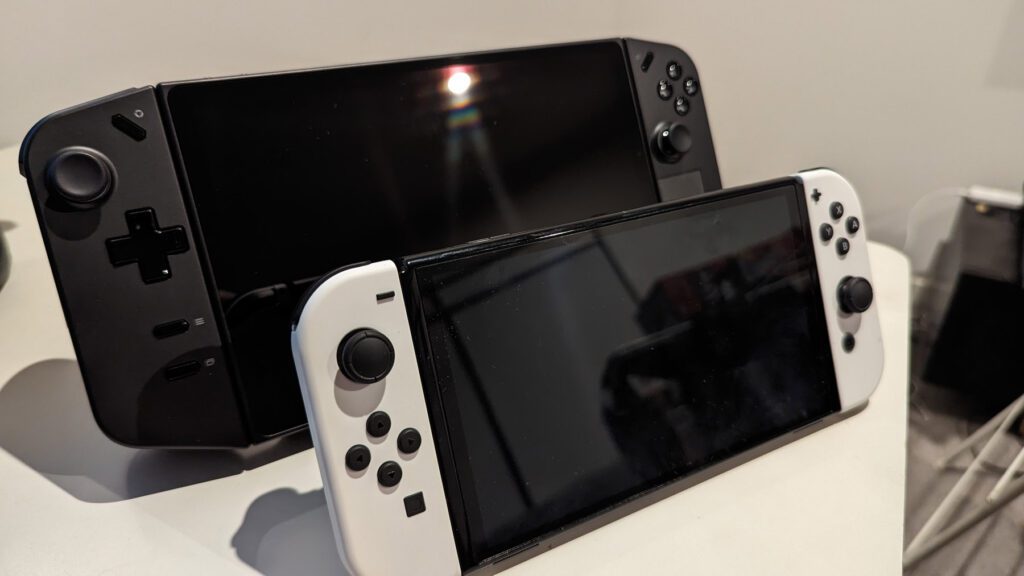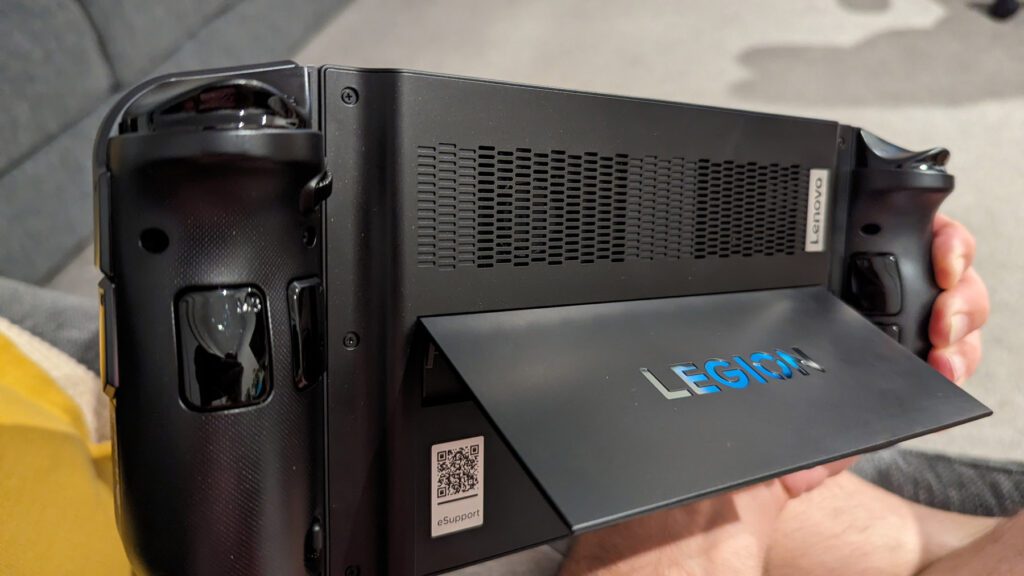Lenovo has entered the portable gaming market with the Legion Go, a Windows-based handheld that offers the flexibility of the Nintendo Switch, mixed with the performance of a PC.
The Legion Go offers a large 8.8″ QHD+ display, detachable controllers, and the promise of playing full-fledged PC games on the go. This is not just a gaming peripheral, but rather a full-blown PC connected to a USB-dock out to a monitor, keyboard and mouse setup, which could actually be your daily driver.
Having lived with the device for a few weeks, it’s time to break down the ownership experience in a full review.
















Design
When you open the box for the Legion Go, you’ll get an immediate appreciation of the scale of this device and it’s certainly not small. It makes the Switch look like a toy, with its’ larger screen and substantial weight.
The Lenovo Legion Go has a grown-up, serious aesthetic in its stealthy black finish helping it stand out from the more playful designs of competitors. The Go features a substantial body, with the large display flanked by detachable controllers and given their size, actually feel great in the hand.
Being an actual computer, the Go features some serious vents around the chassis to allow the heat to escape. The now well-established kickstand design feature allows the screen to stand up at almost any any angle, allowing you to place it on the desk or coffee table while you game using the controllers.
There is an array of buttons on the front, top, back and sides of the device, with many familiar items like the D-pad, thumbsticks, shoulder buttons and top triggers. There’s also some buttons that can be customised to your preference and the familiar X-box style A, B, X, Y buttons. The front also features a Lenovo Legion Button that launches the custom interface to go gaming.
The chassis also features 2x USB-C ports, one on top and one on the bottom which I found was convenient for charging regardless of which configuration you have it in. This was a great decision and really added to the usability of the device.














Features
Lenovo engineers have packed a lot of features into the Legion Go. The most eye-catching feature is the massive 8.8-inch display and while it doesn’t sound like a big step up from a 7″ display, it absolutely feels worlds bigger. This is partly due to the dimensions but also assisted by the panel quality.
The screen runs a crisp 2560 x 1600 resolution in a 16:10 aspect ratio. The display offers a 144Hz refresh rate, one of its best features, given you’re so close to the display, having crisp, clear visuals while gaming is far more important than gaming at a distance.
The display looks amazing, with exceptional clarity and rich colours. Gaming on it is a seriously enjoyable experience and if you want to optimise for battery life, or performance, you have these options in the settings menu. Part of the battery optimisation includes stepping down to lower resolutions and dropping the refresh rate to 60Hz which is still perfectly acceptable for some more casual gaming.
Perhaps the most interesting aspect of this convertible gaming device is the detachable controllers. To remove them, it’s a very simple process, just press the button on the rear of the controller and slide it to remove it from the side of the device, allowing the Legion Go to effortlessly transform from a traditional handheld console into a standalone Windows tablet with touchscreen controls.
The versatility available from this is incredible with the convertible seamlessly moving between 3 different modes.
- Mode 1 – Handheld gaming console
- Mode 2 – Console gaming (controllers removed)
- Mode 3 – PC (USB-C dock)
The ability to move between these modes ultimately speaks to the ambition of this device, it really tries to be all things to all people. The percentage of time you spend in each of these modes will differ dramatically between users but is a very nice feature to have.
Also part of the device’s design is the software layer. Lenovo Space is an included game launcher, while the UI is nice, I found myself regularly launching Steam and launching my games from there, rather than Lenovo Space. Like all software, this can by updated over time and I hope Lenovo evolves this rapidly.








Performance
Under the hood, the Legion Go is powered by an AMD Ryzen Z1 Extreme chip and integrated graphics. This is partnered with 16GB of 7500Mhz RAM and technically up to 1TB NVMe SSD. In Australia it seems we really only get the 512GB spec, but you can expand the storage with micro-SD card slot.
Reflecting on the performance of the device, its most impressive aspect is that you can run the same game you do on PC. For example, I played Palworld Forza Motorsport and Forza Horizon 5.
What I will say is that load times can be lengthy, but once you get the game loaded and set to the right performance spec, the gameplay experience is fantastic.
You should set your expectations accordingly, much like gaming on an ultrabook. There is no RTX4090 here, and while we’re not trying to push 4K graphics, you won’t be running the AAA titles on Ultra and for the most part, that’s ok.
There are times when you have decisions to make, and reducing the resolution to deliver the 144Hz refresh rate can be a trade-off you need to make to land acceptable frame rates. AMD’s FSR upscaling technology does help alleviate some of the limitations but can only do so much.
When you’re not gaming and running the Legion Go as a Windows device, it’ll do just fine for most productivity but try and do some 4K video editing and again you may find limitations. As much as I am a fan of convergence, there is some merit in having dedicated devices that excel at their task and you’ll have to consider if a laptop + console is a better answer to these workloads for you.
If you do need to do some mobile computing, of course, you can pair a Bluetooth mouse and keyboard, or control the mouse using the integrated trackpad. I did struggle a little with it’s positioning and extending my thumb down that far, but as a precision option over the touchscreen, it works quite well.

Issues and Opportunities
The two most significant challenges facing the Lenovo Legion Go are its performance in demanding games and its battery life. Realistically, you can see the battery life drop fairly rapidly when pushing the device hard.
Expect a few hours for demanding AAA games, 4+ hours for lighter games. As always, your screen resolution, refresh rate and brightness contribute heavily here. I do like that switching between Performance, Balanced and Efficiency modes is quite easy, but clearly a device with more battery life would be an advantage over the current 2-cell 49.2WHr. Each controller includes a 900mAh battery which I never found to be a problem, just clip them back on and they charge as the device charges.
While this certainly turns some heads if you engage in a session of mobile gaming on the train, it does leave you wanting when it comes to text entry. When you’re confronted with an on-screen keyboard, you have to re-grip the device to tap with your alternate hand, given the weight of the device.
Additionally, the Lenovo Space launcher experience leaves room for improvement. A more polished and streamlined interface with additional features would significantly enhance the overall user experience.
I did notice on Steam that only a subset of games supported the controllers, so be sure to look out for that. It seemed this was mainly a problem with older titles.


Price and Availability
The Lenovo Legion Go is available now from Lenovo directly or a number of retailers and is currently available at A$1,199.00, a discount of 20% from the normal price of A$1,499.00.
There are often changes in pricing at retail, but at the time of writing, Bing Lee had the lowest price at A$1,107.00. At this price, it firmly competes with the Asus ROG Ally 7″ which currently sells for A$1,099.00 at Centre.com.
The Nintendo Switch OLED (Zelda edition) costs less than half of this at A$499.00 at JB Hi-Fi. The Switch is a very different proposition, despite playing in the same portable gaming space. The Legion Go being priced at more than double the Switch means you’ll really want the extra features on offer to justify the price.


Overall
The Lenovo Legion Go is a compelling and unique offering in the expanding handheld gaming market.
Its strengths lie in its beautiful display, versatile design, and the ability to play a wide range of PC and console titles portably. Those seeking a Windows-based experience and playing their favourite games, rather than a compromised list on alternative platforms, and who are comfortable with shorter sessions, will likely find the Legion Go an appealing choice.
This does in many ways have all the hallmarks of a first-generation device and it’s hard to imagine the Legion 3 not tidying up some of the shortcomings here, albeit a great first entry to the portable gaming device category.
There’s no doubt that the experience of having played Forza on the PC or Xbox, then leaving the house and continuing where you left off on the Legion Go is a fantastic option to have. I do wish game load times and battery life were better, but this is where we are in 2024.
If you’re in the market for a portable gaming solution that also performs double-duty as a full-blown Windows computer, then Lenovo has a compelling option, just be aware of its strengths and drawbacks as outlined above.
